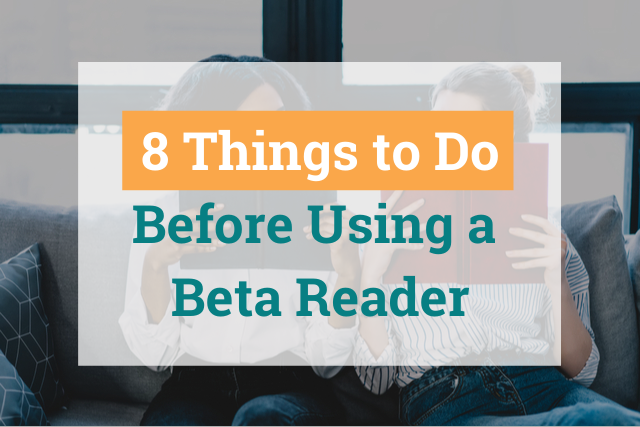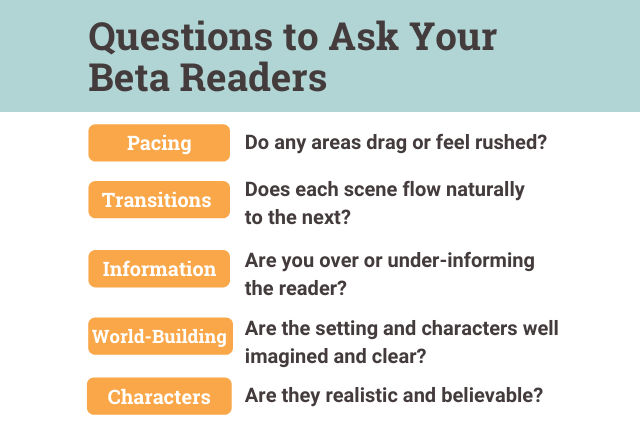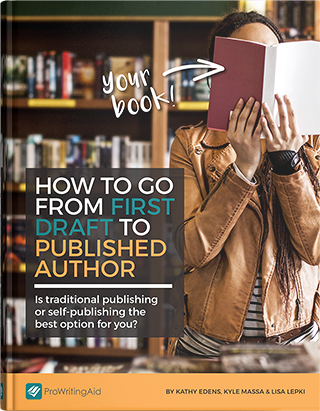
If you’re writing a novel or non-fiction book, you might consider using beta readers. A beta reader is someone who reads and reviews your writing for you. They could be someone you pay as a professional reader, but it’s far more likely you’ll use a friend or family member, a fellow writer, or a volunteer.
Most writers will ask a few beta readers (but not too many) to receive a rounded impression of their work. Each will bring a unique perspective. When a few beta readers comment on the same issue, you know you’ve found a problem you’ll need to fix.
But what should you do before sending your writing to your beta readers? Below we talk you through eight essential steps before you send your precious manuscript off for reading. Each step will save you time, get you organised, or help you make the most out of using beta readers.
1: Check the Basics
You must thoroughly check your writing for grammatical and spelling mistakes before it goes to your beta readers. Not only are these mistakes distracting and annoying, but they make it harder to read your writing. It also creates a terrible impression of your abilities.
If your work is full of errors, they’ll become the sole focus of the feedback you receive. You want your beta readers to look deeper than typos and mistakes into the writing itself.
ProWritingAid is a simple, but effective way to eliminate those pesky mistakes. It goes far deeper than a simple spelling checker, giving you a complete analysis of your writing. You can choose to upload your writing onto the ProWritingAid website, or use one of our handy integrations.
Check out this quick demo of our Realtime checker:
Cleaning up your grammar and spelling mistakes before you send your manuscript off for reading will save you a lot of time in sorting through feedback. Correct mistakes with just a few clicks with ProWritingAid.
2: Improve Your Readability
It should be easy to read your writing, even if you’re talking about a hard concept. Avoid using complex and difficult words or writing in long and dense sentences. Both will turn your reader off and need to be eliminated before sending to your beta readers.
Improving readability means looking at each paragraph to see how easy it is to read and breaking up dense, complex sections of text. Reading your work aloud is a simple technique to find problems with readability. When you stumble or struggle to read a sentence, you’ll have found an issue you can improve on.
ProWritingAid has a range of reports that will help you improve the readability of your work, including looking at consistency and finding overused words. Get familiar with your favourite reports and put them together to create your own personalised, one-click combo check.
3: Get the Structure of Your Scenes and Chapters Right
Your writing should have gone through several rounds of self-editing (at least) before you send it to a beta reader. Don’t just check for spelling mistakes, look at the bigger picture to check the overall structure and flow of each scene.
You’ll often find you keep beginning sentences in the same way or over-rely on similar sentence lengths. Finding and adjusting these makes your writing more interesting to read. ProWritingAid will help you tackle any issues. Our pacing, transition, and structure reports will help you identify potential problems.
Watch how the pacing report helps you make sure your reader keeps turning pages:
4: Choose the Best Document Format
Your beta readers will need to add comments and highlight problems in your work. Every beta reader will have different suggestions to make and will have their own way of working. Avoid saving your work as a PDF or any other document type that stops them from adding comments.
Make your text clear to read by increasing the space between your lines (using spacing options rather than leaving blank lines) and by using a sensible font size. Choose a simple-to-read font like Calibri or Arial rather than a cursive script or difficult font like Comic Sans.
If you have more than one beta reader, you’ll need a simple way to keep their ideas together and organised without having to type them up. Consider using online options, like Google Docs, that let different beta readers add comments to the same copy of your document. Just remember to keep a copy of your original version safe in case of accidents. Alternatively, use Microsoft Word and save a copy for each of your beta readers, then merge them together at a later point.
5: Decide How You Will Thank Them
Generally, beta readers will review your writing for free. Think about what you can do to thank them or encourage them to take the time to read your work. It’s best to be clear about this before you reach out to find them.
You could offer:
- A free copy of your book
- A mention in the acknowledgements (if they go above and beyond in helping you)
- A reciprocal arrangement where you offer to beta-read their book in return
- Payment—if you want a specialist type of beta reader such as a sensitivity reader
Beta readers give up a lot of their time for little or no reward. Just saying thank you and making it clear you appreciate their feedback (especially if it’s not been as positive as you’d like) will show you recognize their value.
6: Plan Your Deadlines
Beta readers appreciate knowing your deadlines before they start. Think about any other commitments you may have, such as booking an editor or meeting publication deadlines. Sharing your timelines will help you find beta readers who have the time available to help you.
You don’t want to put pressure on your beta reader, particularly if they’re reviewing your writing for free, but being open about your deadlines prevents you feeling frustrated when you don’t receive feedback in good time.
7: Ask Specific Questions
There will be sections of your writing that you’re not as confident about. Is the transition clear between these two scenes? Is this character likeable enough? Does this section feel too slow? Asking specific questions ensures you’ll get comments about the areas that are worrying you.
You might ask your beta readers to focus on specific places. Be clear that doesn’t mean you want them to only look at the areas you’ve requested. After all, they may spot issues you’ve not noticed. Alternatively, create a list of follow-up questions you can bring up if they aren’t mentioned in the feedback you receive.
Typical questions could focus on:
- Pacing: Do any areas drag or feel rushed?
- Transitions: Does each scene flow naturally to the next?
- Level of information: Are you over or under-informing the reader?
- World-Building: Are the setting and characters well imagined and clear?
- Characters: Are they realistic and believable?

8: Find the Best Beta Readers for You
There are lots of places to find beta readers. While you might naturally turn first to close friends and family, they might not always be the best choice for a balanced opinion. Relatives and close friends are unlikely to want to raise problems or give you the honest feedback you need.
Instead, choose people who aren’t afraid to be honest, friends-of-friends, and people from your target audience. Above all else, look for beta readers who are reliable. Start searching for potential readers before you need them by joining social media groups and writer communities.
Final Thoughts
There’s no rule saying you must use beta readers, but remember it’s hard to stay objective about your own writing. Your precious manuscript becomes your baby. As you’ve lived with your writing for so long, it’s hard for you to see where changes are needed.
A beta reader doesn’t replace an editor, but they give you a reader’s impression of your writing. This is invaluable when you’re trying to see how successful your work is. Using a beta reader means when you send work to an editor it is as good as you can make it.
Preparing your work thoroughly before sending it to your beta readers ensures you’ll get the most from the experience. You’ll receive the feedback that helps you identify problems and make necessary changes. So, before you send off your manuscript, make sure it’s really ready for them.


